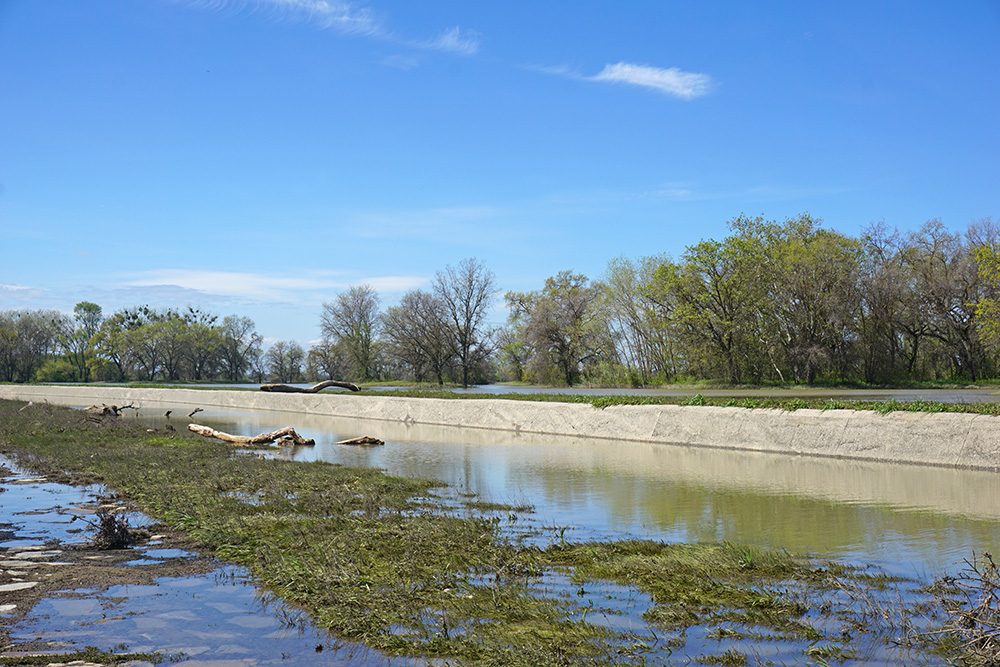- Reclamation
- News & Multimedia
- News Releases
- News Release Archive
- Reclamation, DWR take steps to improve habitat for endangered salmon at the Yolo Bypass
News Release Archive
Reclamation, DWR take steps to improve habitat for endangered salmon at the Yolo Bypass
Agencies to increase floodplain fisheries-rearing habitat and improve fish passage at Fremont Weir
Media Contact:
Jeff Hawk, 916-978-5100 (O) 916-204-2348 (C), jhawk@usbr.gov
For Release: June 07, 2019

The Fremont Weir (pictured) is a 1.8-mile-long concrete structure designed to allow flow into the Yolo Bypass during high-flow. Once the Sacramento River recedes below its crest, fish are likely to become stranded in the stilling basin.SACRAMENTO, Calif. – The Bureau of Reclamation and the California Department of Water Resources have evaluated options to improve fish passage and increase floodplain fisheries-rearing habitat in the Yolo Bypass, near Sacramento. These options explore how to benefit Sacramento River winter-run Chinook salmon, Central Valley spring-run Chinook salmon, Central Valley steelhead and the southern distinct population segment of North American green sturgeon. The agencies released environmental documents that analyze six action alternatives including a headworks structure at Fremont Weir and downstream channel improvements.
“The Yolo Bypass is both a prominent element of California’s flood control system and a critical migration corridor for fish,” said Mid-Pacific Regional Director Ernest Conant. “This project shows what we can do when we work with our state and local partners to address fish and water supply reliability in California. I look forward to our work together to restore habitat while continuing existing land use.”
The project aims to increase the connection of water and fish entering the Yolo Bypass, California’s largest continuous floodplain made up of 59,000 acres. This project will also provide seasonal inundation that mimics the natural process of the Yolo Bypass floodplain during winter and improves connectivity within the bypass and to the Sacramento River. This enables juvenile salmon to feed in a food-rich area for a longer time, allowing them to grow rapidly in size and improving their chances of survival as they travel to the ocean.
The project primarily consists of a new structure at the head of the Fremont Weir, also known as a headworks structure, and channel improvements to an outlet and downstream channels. The new construction would connect floodplain habitat over the winter, when flooding occurs. Connecting floodplain habitat over the winter avoids significant impacts to land uses by operating within existing hydrology and outside of the agriculture season.
The project meets requirements of the National Marine Fisheries Service 2009 Biological Opinion on the Long-Term Operations of the Central Valley Project and the State Water Project (LTO) and is part of the Reinitiation of Consultation (ROC) on LTO.
The Final Environmental Impact Statement is prepared in accordance with the National Environmental Policy Act and available at https://www.usbr.gov/mp/nepa/nepa_project_details.php?Project_ID=30484. Hard copies of the documents can be reviewed at the Bureau of Reclamation, Bay-Delta Office, 801 I Street, Suite 140, Sacramento, CA. Call to make an appointment (916-414-2400). To request a copy of the documents, contact Ben Nelson at 916-414-2424 (TTY 800-877-8339), bnelson@usbr.gov.
For additional information on the Yolo Bypass Salmonid Habitat Restoration and Fish Passage Project, visit https://www.usbr.gov/mp/bdo/yolo-bypass.html.
# # #
The Bureau of Reclamation is a federal agency under the U.S. Department of the Interior and is the nation's largest wholesale water supplier and second largest producer of hydroelectric power. Our facilities also provide substantial flood control, recreation opportunities, and environmental benefits. Visit our website at https://www.usbr.gov and follow us on Twitter @USBR; Facebook @bureau.of.reclamation; LinkedIn @Bureau of Reclamation; Instagram @bureau_of_reclamation; and YouTube @reclamation.

